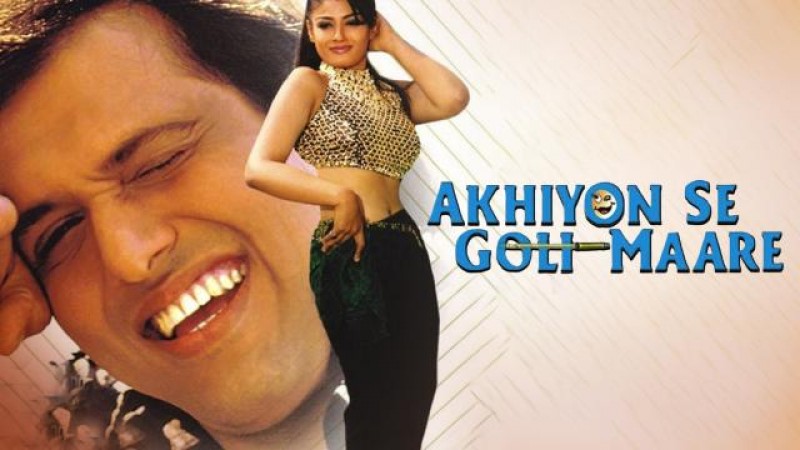
Indian cinema is renowned for its ability to inspire and amuse audiences with a wide variety of genres and styles. Govinda, renowned for his flawless comic timing and dance prowess, is among the most adored and versatile actors in Bollywood. There is a famous scene in the history of Bollywood where Govinda entertains himself by quickly switching channels on the TV. This scene has left an indelible impression on viewers. The Marathi film "Balache Baap Brahmachari" (1989), which served as the inspiration for this iconic scene that has become synonymous with Govinda's filmography, was the source of this idea. The genesis of this well-known scene and its cultural significance will be covered in detail in this article.
Bollywood comedy "Bade Miyan Chote Miyan" (1998), helmed by David Dhawan, features Govinda and Amitabh Bachchan in the lead roles. The scene in which Govinda's character, Pyare Mohan, tries to amuse himself and his partner by quickly changing TV channels is one of the most memorable and hilarious ones in the film. Govinda's uncanny ability to imitate various characters and genres creates a rollercoaster of humorous moments in the scene.
However, a lesser-known Marathi movie called "Balache Baap Brahmachari" (1989) is where this iconic scene's origins can be found. The lead actor in this movie, played by seasoned Marathi actor Ashok Saraf, was directed by R. D. Nagarekar. The movie itself may not have attracted much attention outside of the Marathi-speaking audience, but it did feature a humorous TV channel-hopping scene that served as the model for the successful Bollywood film.
The protagonist of "Balache Baap Brahmachari," played by Ashok Saraf, is forced to keep a young child amused. He quickly switches TV channels in an effort to imitate the various characters and shows he encounters because he has a limited amount of resources available. Ashok Saraf's seamless switching between various personas, including impersonations of well-known actors and popular TV shows from the time period, make for a masterclass in comedic timing in this scene.
The "Balache Baap Brahmachari" TV channel-swapping scene struck a chord with viewers, especially those who were familiar with Marathi film. It became a famous moment in Marathi film history thanks to its contagious humor and Ashok Saraf's impeccable comic timing. Nobody anticipated that "Bade Miyan Chote Miyan" would take inspiration from this scene and create a similar but distinctively Bollywood version.
Govinda's Pyare Mohan, who appears in "Bade Miyan Chote Miyan," encounters a situation where he must amuse his companion. What is the clever remedy? A television and a flurry of channel flipping. Drawing inspiration from "Balache Baap Brahmachari," Govinda takes viewers on a wild journey through various TV shows and characters. Govinda's performance served as proof of his versatility as an actor, whether he was channeling Amitabh Bachchan's iconic "Don" character or a melodramatic soap opera actor.
The "Bade Miyan Chote Miyan" TV channel-hopping scene is more than just comic relief; it captures the Indian cultural environment of the late 1990s. A wide variety of programs, including soap operas, newscasts, and Bollywood movies, were available on television at the time, which was starting to take over Indian households. Govinda's channel-hopping escapade reflected the variety of programming available on Indian TV, making it relevant to the target demographic at the time.
Furthermore, Govinda's aptitude for switching between various characters and genres with ease demonstrated the diversity of Indian entertainment. It was a celebration of the different components that combine to make Indian film and television so distinctive—comedy, drama, action, and romance—all rolled into one unforgettable scene.
Bollywood comedy will never be the same after the TV channel-switching scene from "Bade Miyan Chote Miyan" was released. Its influence can be seen in later films and performances, where actors frequently try to recreate the channel-switching frenzy in their own performances. The bar for comedic performances in Indian cinema has been raised by Govinda's innovative use of mimicry and physical humor in this scene.
Additionally, the scene honors "Balache Baap Brahmachari," the work that served as its inspiration. It emphasizes the interconnectedness of Indian regional cinemas by adapting and reimagining the Marathi original in a Bollywood context. It serves as a reminder that ideas and creativity can freely flow between people of different linguistic backgrounds, enhancing the tapestry of Indian cinema.
The famous TV channel scene from the Bollywood film "Bade Miyan Chote Miyan" is proof of the long-lasting impact of regional cinema. Govinda's outstanding performance, which took inspiration from the Marathi movie "Balache Baap Brahmachari," has earned its rightful place in the annals of Indian cinematic history. The late 1990s Indian cultural landscape was reflected in it, as well as the humor it used to amuse audiences.
As we reflect on this iconic moment in Indian cinema, where creativity knows no bounds and innovation thrives, we celebrate the creative spirit of the industry. For devotees of Bollywood comedy, Govinda's channel-surfing extravaganza is still a treasured memory. The scene honors its Marathi forerunner while still delighting viewers and generating laughter.
A Comic Copy-Paste: The Scene That Shook Bollywood's Foundations